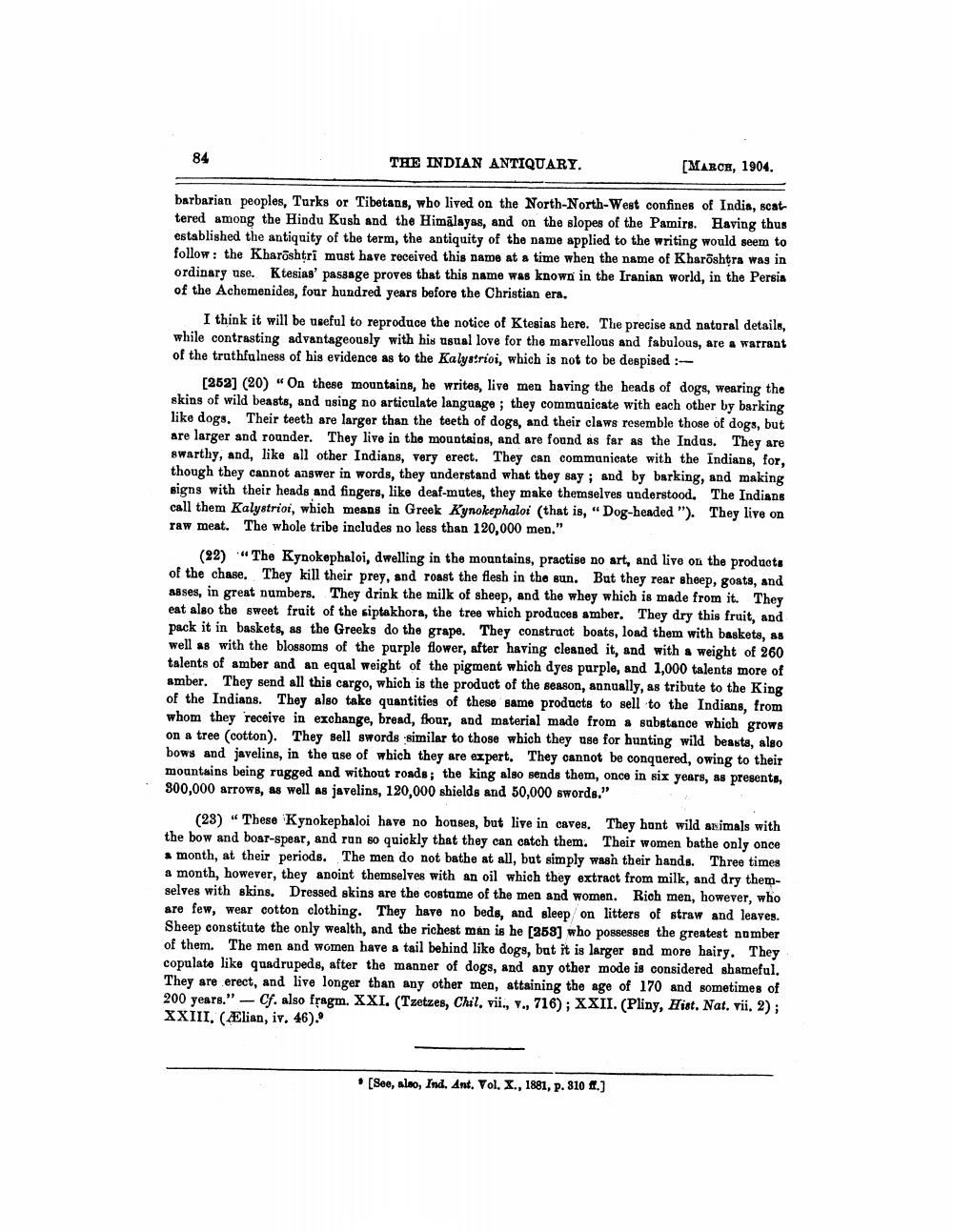________________
84
THE INDIAN ANTIQUARY.
[MARCH, 1904.
barbarian peoples, Turks or Tibetans, who lived on the North-North-West confines of Indis, scat tered among the Hindu Kush and the Himalayas, and on the slopes of the Pamirs. Having thus established the antiquity of the term, the antiquity of the name applied to the writing would seem to follow: the Kharðshtri must have received this name at a time when the name of Kharöshtra was in ordinary use. Ktesias' passage proves that this name was known in the Iranian world, in the Persia of the Achemenides, four hundred years before the Christian era.
I think it will be useful to reproduce the notice of Ktesias here. The precise and natural details, while contrasting advantageously with his usual love for the marvellous and fabulous, are a warrant of the truthfulness of his evidence as to the Kalystrioi, which is not to be despised -
[252] (20) “On these mountains, he writes, live men baving the heads of dogs, wearing the skins of wild beasts, and using no articulate language; they communicate with each other by barking like dogs. Their teeth are larger than the teeth of dogs, and their claws resemble those of dogs, but are larger and rounder. They live in the mountains, and are found as far as the Indus. They are swarthy, and, like all other Indians, very erect. They can communicate with the Indians, for, though they cannot answer in words, they understand what they say; and by barking, and making signs with their heads and fingers, like deaf-mutes, they make themselves understood, The Indians call them Kalystrioi, which means in Greek Kynokephaloi (that is, "Dog-headed "). They live on raw meat. The whole tribe includes no less than 120,000 men."
(22) "The Kynokophaloi, dwelling in the mountains, practise no art, and live on the products of the chase. They kill their prey, and roast the flesh in the sun. Bat they rear sheep, goats, and asses, in great numbers. They drink the milk of sheep, and the whey which is made from it. They eat also the sweet fruit of the siptakhora, the tree which produces amber. They dry this fruit, and pack it in baskets, as the Greeks do the grape. They constract boats, load them with baskets, as well as with the blossoms of the purple flower, after having cleaned it, and with a weight of 260 talents of amber and an equal weight of the pigment which dyes purple, and 1,000 talents more of amber. They send all this cargo, which is the product of the season, annually, as tribute to the King of the Indians. They also take quantities of these same products to sell to the Indians, from whom they receive in exchange, bread, flour, and material made from a substance which grows on a tree (cotton). They sell swords similar to those which they use for hunting wild beasts, also bows and javelins, in the use of which they are expert. They cannot be conquered, owing to their mountains being rugged and without roads; the king also sends them, once in six years, as presents, 800,000 arrows, as well as javelins, 120,000 shields and 50,000 swords."
(23) · These Kynokephaloi have no houses, but live in caves. They hunt wild animals with the bow and boar-spear, and run so quickly that they can catch them. Their women bathe only once a month, at their periods. The men do not bathe at all, but simply wash their hands. Three times a month, however, they anoint themselves with an oil which they extract from milk, and dry themselves with skins. Dressed skins are the costume of the men and women. Rich men, however, who are few, wear cotton clothing. They have no beds, and sleep on litters of straw and leaves. Sheep constitute the only wealth, and the richest man is he [258] who possesses the greatest nomber of them. The men and women have a tail behind like dogs, but it is larger and more hairy. They copulate like quadrupeds, after the manner of dogs, and any other mode is considered shameful. They are erect, and live longer than any other men, attaining the age of 170 and sometimes of 200 years." - Cf. also fragm. XXI. (Tzetzes, Chil, vii., Y., 716) ; XXII. (Pliny, Hist. Nat. vii. 2); XXIII. (Ælian, iv. 46).
[See, also, Ind. Ant. Vol. X., 1881, p. 810 .)




